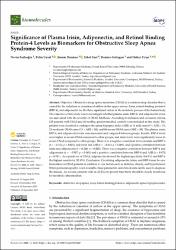| dc.contributor.author | Fazlıoğlu, Nevin | |
| dc.contributor.author | Uysal, Pelin | |
| dc.contributor.author | Durmuş, Sinem | |
| dc.contributor.author | Yurt, Sibel | |
| dc.contributor.author | Gelişgen, Remise | |
| dc.contributor.author | Uzun, Hafize | |
| dc.date.accessioned | 2024-04-16T13:14:49Z | |
| dc.date.available | 2024-04-16T13:14:49Z | |
| dc.date.issued | 2023 | en_US |
| dc.identifier.citation | Fazlıoğlu, N., Uysal, P., Durmuş, S., Yurt, S., Gelişgen, R., & Uzun, H. (2023). Significance of Plasma Irisin, Adiponectin, and Retinol Binding Protein-4 Levels as Biomarkers for Obstructive Sleep Apnea Syndrome Severity. Journal Information BIOMOLECULES, 13(10), 1-12. https://doi.org/10.3390/biom13101440 | en_US |
| dc.identifier.issn | 2218-273X | |
| dc.identifier.uri | https://hdl.handle.net/20.500.12900/338 | |
| dc.description.abstract | Objective: Obstructive sleep apnea syndrome (OSAS) is a common sleep disorder that is caused by the reduction or cessation of airflow in the upper airway. Irisin, retinol-binding protein-4 (RBP-4), and adiponectin are the three significant factors in the metabolic process of the human body. The objective of this study was to investigate whether plasma irisin, RBP-4, and adiponectin levels are associated with the severity of OSAS. Methods: According to inclusion and exclusion criteria, 125 patients with OSAS and 46 healthy, gender-matched controls were included in this study. The patients were classified according to the apnea hypopnea index (AHI) as 14 mild cases (5 < AHI < 15), 23 moderate OSAS cases (15 < AHI < 30), and 88 severe OSAS cases (AHI > 30). The plasma irisin, RBP-4, and adiponectin levels were measured and compared between groups. Results: RBP-4 levels were higher in severe OSAS compared to other groups, and irisin levels were significantly lower in severe OSAS compared to other groups. There was a negative correlation between irisin and RBP-4 (r = -0.421; p < 0.001), and irisin and AHI (r = -0.834; p < 0.001), and a positive correlation between irisin and adiponectin (r = 0.240; p = 0.002). There was a negative correlation between RBP-4 and adiponectin (r = -0.507; p < 0.001) and a positive correlation between RBP-4 and AHI (r = 0.473; p < 0.001). As a predictor of OSAS, adiponectin showed the highest specificity (84.8%) and RBP-4 the highest sensitivity (92.0%). Conclusion: Circulating adiponectin, irisin, and RBP-4 may be new biomarkers in OSAS patients in addition to risk factors such as diabetes, obesity, and hypertension. When polysomnography is not available, these parameters and clinical data can be used to diagnose the disease. As a result, patients with an AHI score greater than thirty should be closely monitored for metabolic abnormalities. | en_US |
| dc.language.iso | eng | en_US |
| dc.publisher | MDPI | en_US |
| dc.relation.isversionof | 10.3390/biom13101440 | en_US |
| dc.rights | info:eu-repo/semantics/openAccess | en_US |
| dc.subject | Obstrüktif uyku apnesi | en_US |
| dc.subject | Obstructive sleep apnea | en_US |
| dc.subject | Retinol bağlayıcı protein-4 | en_US |
| dc.subject | Retinol-binding protein-4 | en_US |
| dc.subject | Apne hipopne indeksi | en_US |
| dc.subject | Apnea hypopnea index | en_US |
| dc.title | Significance of Plasma Irisin, Adiponectin, and Retinol Binding Protein-4 Levels as Biomarkers for Obstructive Sleep Apnea Syndrome Severity | en_US |
| dc.type | article | en_US |
| dc.department | İstanbul Atlas Üniversitesi, Tıp Fakültesi, Temel Tıp Bilimleri Bölümü | en_US |
| dc.authorid | https://orcid.org/0000-0002-1347-8498 | en_US |
| dc.contributor.institutionauthor | Uzun, Hafize | |
| dc.identifier.volume | 13 | en_US |
| dc.identifier.issue | 10 | en_US |
| dc.identifier.startpage | 1 | en_US |
| dc.identifier.endpage | 12 | en_US |
| dc.relation.journal | BIOMOLECULES | en_US |
| dc.relation.publicationcategory | Makale - Uluslararası Hakemli Dergi - Kurum Öğretim Elemanı | en_US |

















